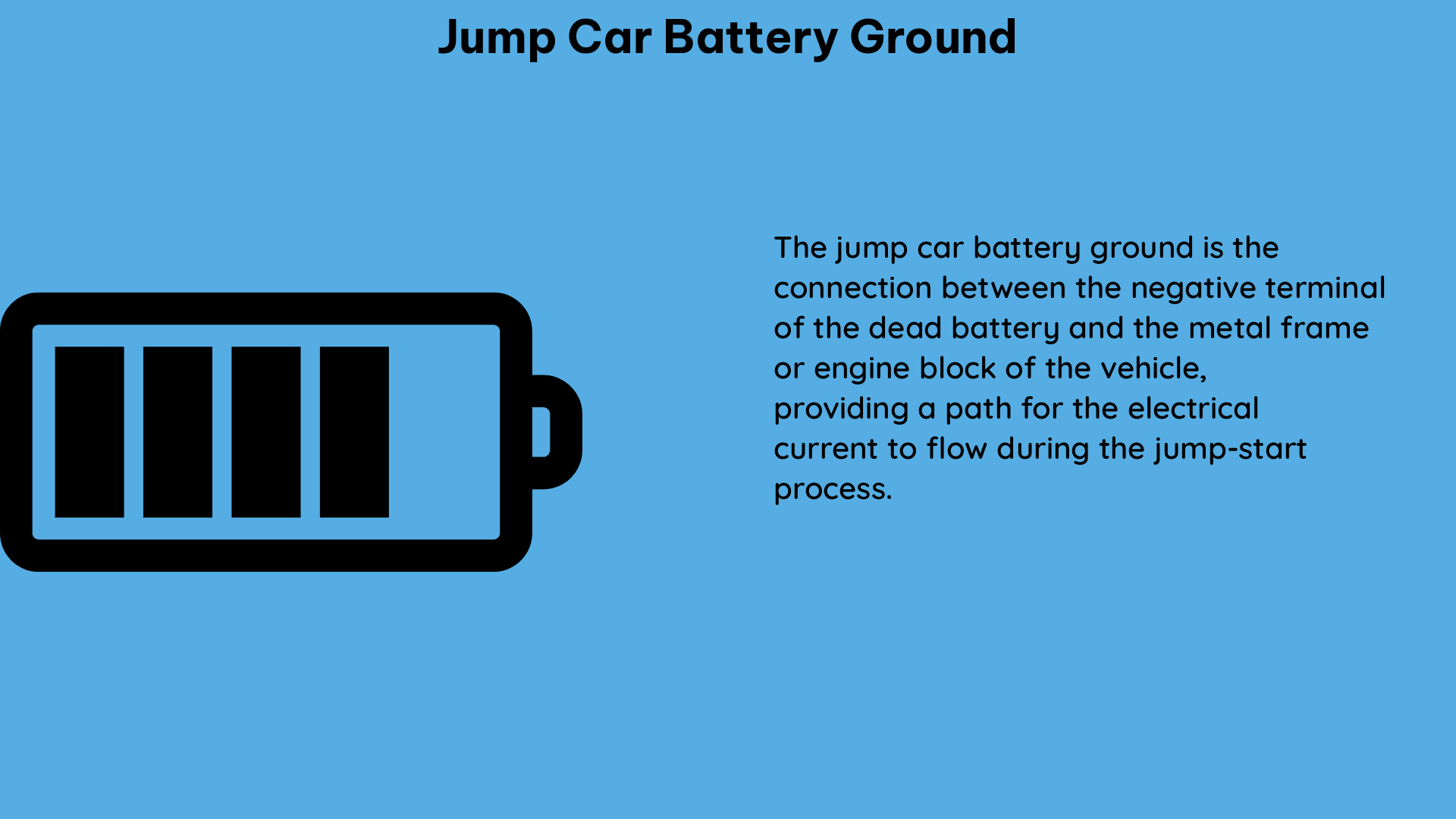When your car’s battery dies, jump-starting it can be a lifesaver. However, the process of jump-starting a car requires careful attention to ensure safety and proper connection. One critical aspect of jump-starting is the ground connection, which is often overlooked but plays a crucial role in the process.
Technical Specifications of Jump Car Battery Ground
To ensure a successful and safe jump-start, it’s essential to understand the technical specifications of the jump car battery ground:
-
Jumper Cable Gauge: The jumper cables should be at least 12 gauge to handle the high current required to jump-start a car. Thicker cables can better withstand the electrical load and reduce the risk of overheating or fire.
-
Jumper Cable Length: The length of the jumper cables should be at least 12 feet to allow for sufficient distance between the two cars. This distance helps prevent sparks from the battery terminals from igniting any flammable materials nearby.
-
Jumper Cable Clamps: The clamps on the jumper cables should be made of copper or another highly conductive material to ensure a secure and reliable connection. Avoid using clamps with any signs of corrosion or damage.
-
Ground Point: The ground point on the dead car should be a stable, non-moving point with good electrical conductivity, such as the engine block. Avoid using the battery’s negative terminal, as it is directly connected to the car’s bodywork, which can increase the risk of sparks.
-
Connection Order: When connecting the jumper cables, the negative jumper should be connected to the ground point on the dead car before connecting the positive jumper to the good battery. This sequence helps prevent sparks near the dead battery, reducing the risk of explosion.
DIY Jump Car Battery Ground

To perform a DIY jump car battery ground, follow these step-by-step instructions:
-
Ensure Safety: Make sure both cars are turned off, and the keys are removed from the ignition. This prevents any accidental starting or movement of the vehicles during the jump-start process.
-
Connect Positive Jumper: Attach the positive (red) clamp of the jumper cable to the positive terminal of the dead battery.
-
Connect Positive to Good Battery: Connect the other end of the positive jumper cable to the positive terminal of the good battery.
-
Connect Negative Jumper: Attach the negative (black) clamp of the jumper cable to a stable ground point on the dead car, such as the engine block or a metal bolt on the engine. Avoid connecting it directly to the negative terminal of the dead battery.
-
Connect Negative to Good Battery: Connect the other end of the negative jumper cable to the negative terminal of the good battery.
-
Start the Good Car: Start the car with the good battery and let it run for a few minutes to allow the dead battery to charge.
-
Start the Dead Car: Try starting the car with the dead battery. If it doesn’t start, wait a few more minutes and try again.
-
Disconnect Jumper Cables: Once the dead car has started, disconnect the jumper cables in the reverse order: first the negative jumper from the good battery, then the negative jumper from the ground point on the dead car, followed by the positive jumper from the good battery, and finally the positive jumper from the dead battery.
Remember, it’s crucial to follow the correct connection order and ensure that the jumper cables are not touching any moving parts or fuel system components during the process.
Additional Considerations
-
Accessible Negative Terminal: If the negative terminal of the dead battery is not easily accessible, you can use a metal bolt or other ground point on the engine block as the ground connection. This is a common scenario when the battery is located in a hard-to-reach area.
-
Corrosion and Damage: Inspect the jumper cables and battery terminals for any signs of corrosion or damage before use. Damaged or corroded components can compromise the electrical connection and increase the risk of sparks or fire.
-
Battery Condition: If the dead battery is severely discharged or damaged, jump-starting may not be effective. In such cases, it’s best to replace the battery or have it professionally tested and charged.
-
Safety Precautions: Always wear protective eyewear and keep your face away from the battery terminals during the jump-start process. Avoid smoking or using any open flames near the battery, as it can produce flammable hydrogen gas.
By following the technical specifications and the step-by-step DIY instructions, you can safely and effectively jump-start your car’s battery, ensuring a smooth and reliable restart.
References:
– Why Does the Black Jumper Cable Get Grounded and Not Hooked to the Negative on the Dead Battery?
– How Am I Able to Jump My Car When I Ground One of the Jumpers?
– Can Someone Help Me Feel Safe by Pointing at the Correct Way to Jump Start a Car?
– Using a Car with an Inaccessible Negative Battery Terminal to Jump Start
– How to Jump Start a Car

The lambdageeks.com Core SME Team is a group of experienced subject matter experts from diverse scientific and technical fields including Physics, Chemistry, Technology,Electronics & Electrical Engineering, Automotive, Mechanical Engineering. Our team collaborates to create high-quality, well-researched articles on a wide range of science and technology topics for the lambdageeks.com website.
All Our Senior SME are having more than 7 Years of experience in the respective fields . They are either Working Industry Professionals or assocaited With different Universities. Refer Our Authors Page to get to know About our Core SMEs.